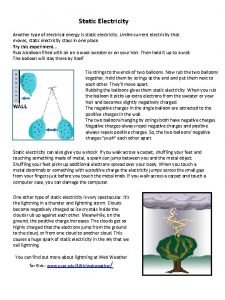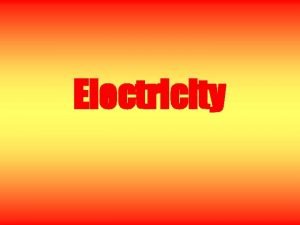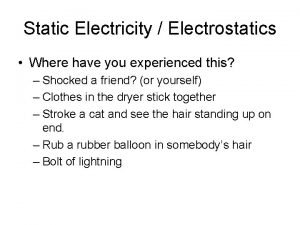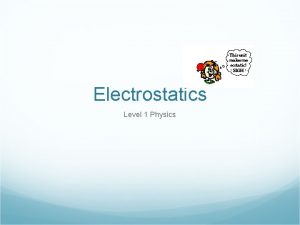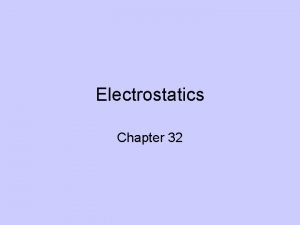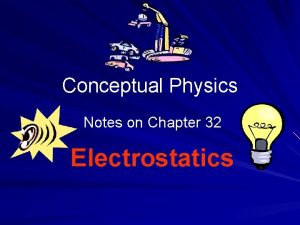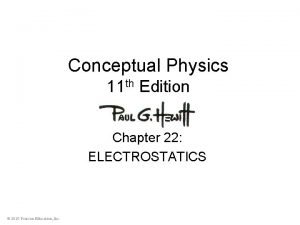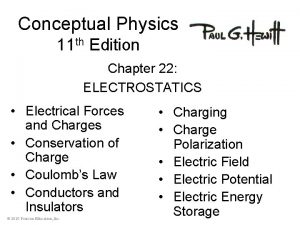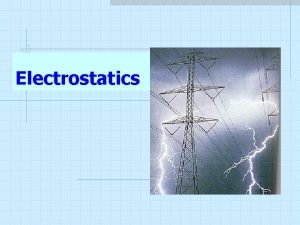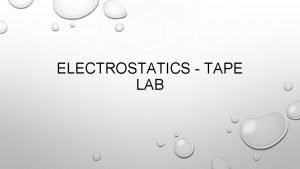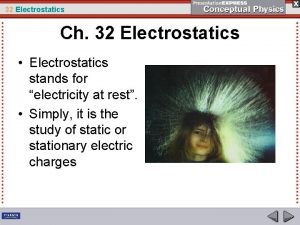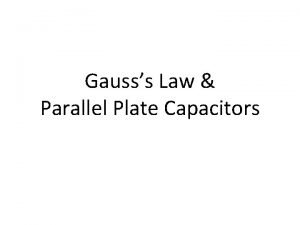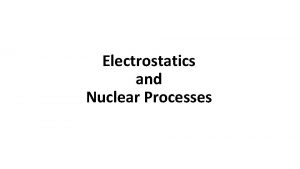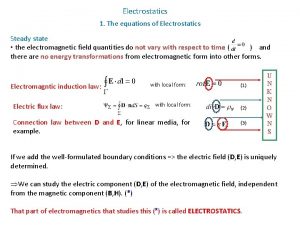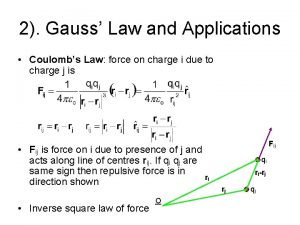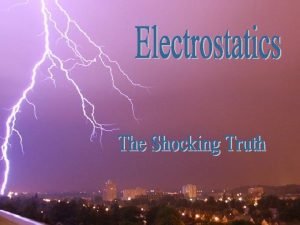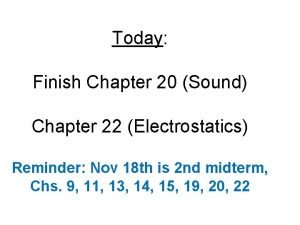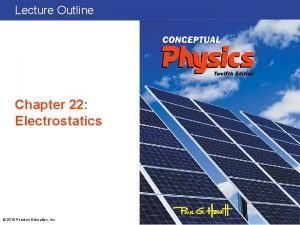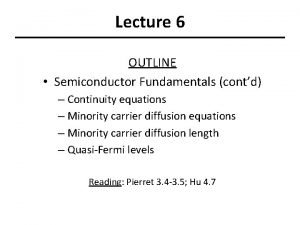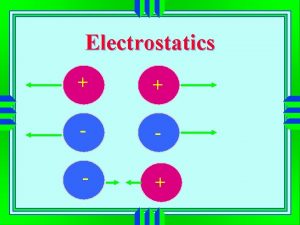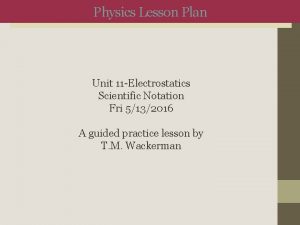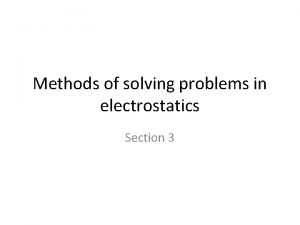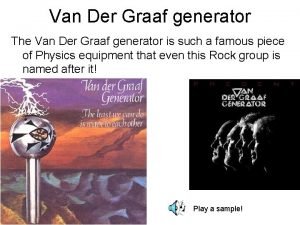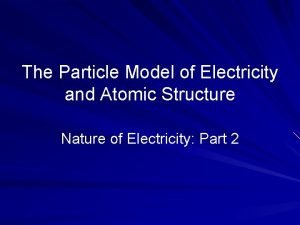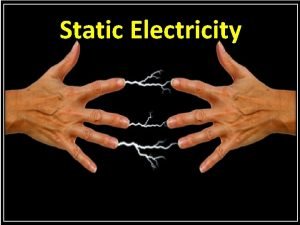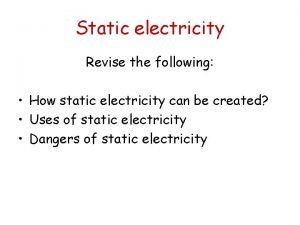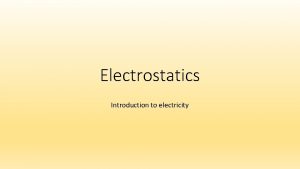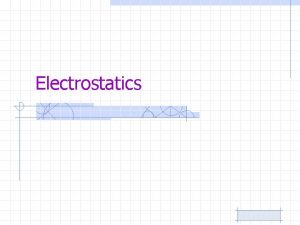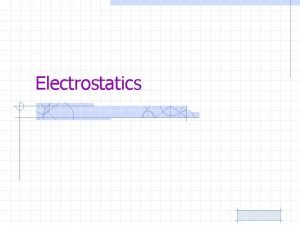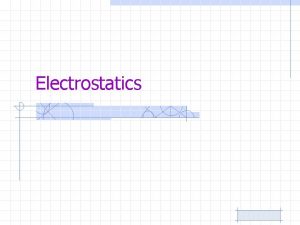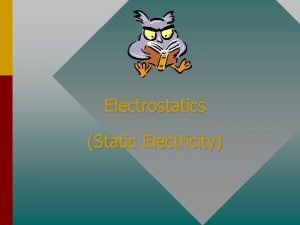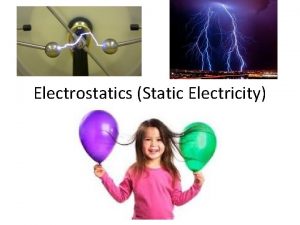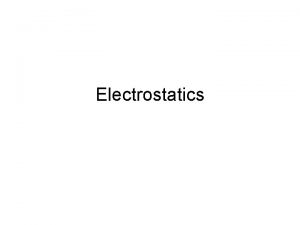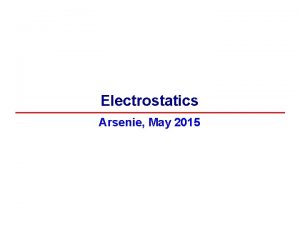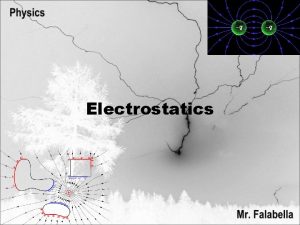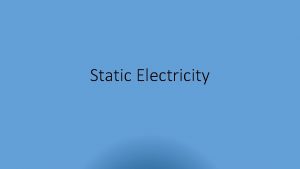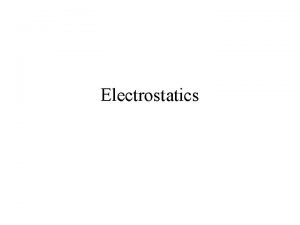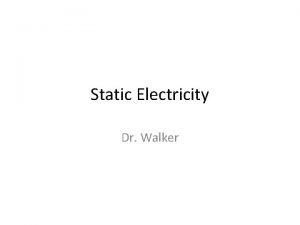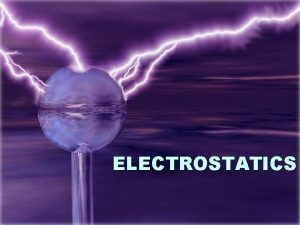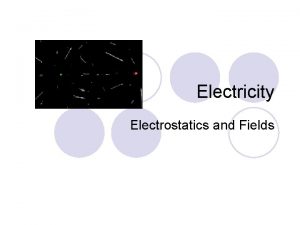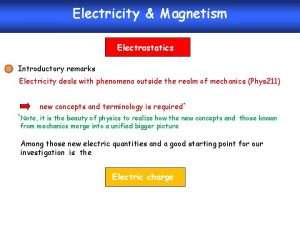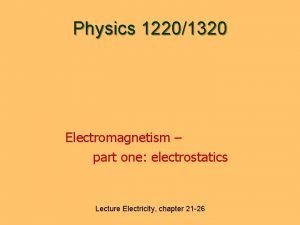EM Electrostatics Electrostatics Electricity in one form or

















































- Slides: 49

E&M Electrostatics

Electrostatics • Electricity in one form or another underlies just about everything around you. • Electrostatics is electricity at rest. • Electrostatics involves electric charges, the forces between them, and their behavior in materials.

Electrical Charges There are two types of electrical charges: A positive charge, such as the charge on a proton. A negative charge, such as the charge on an electron. Charge is conserved, meaning it is neither created nor destroyed. Charge is also quantized, meaning that it occurs in discrete amounts.

Characteristics of Electric Charge Electric charges exist in two varieties, referred to as positive and negative charges. Charge is conserved, meaning it is neither created nor destroyed. Charge is also quantized, meaning that it occurs in discrete amounts.

Electrical Forces • An electrical force is a force that one charge exerts on another. • When the charges are the same sign, they repel; when the charges are opposite, they attract. • Electrical forces arise from the particles in atoms – protons and electrons.

Electrical Forces vs. Gravitational Forces Although electrical forces are billions and billions of times stronger than gravitational forces, the enormous attractive and repulsive electrical forces between the charges in Earth and the charges in your body balance out, leaving the relatively weaker force of gravity, which attracts only. Hence your weight is due only to gravity.

Review of the Atom • Every atom has a positively charged nucleus surrounded by negatively charged electrons. • All electrons are identical; that is, each has the same mass and the same quantity of negative charge as every other electron. • The nucleus is composed of protons and neutrons (except protium). • All protons are identical to each other. • All neutrons are identical to each other. • A proton has nearly 2000 times the mass of an electron, but its positive charge is equal in magnitude to the negative charge of an electron. • A neutron has slightly greater mass than a proton and has no charge. • Atoms usually have as many electrons as protons, so the atom has a zero net charge.

A Quick Peek at Quantum Physics Why don’t protons pull the oppositely charged electrons into the nucleus? Within atoms, different laws of physics apply. This is the domain of quantum physics. According to quantum physics, an electron behaves like a wave and has to occupy a certain amount of space related to its wavelength. The size of an atoms is set by the minimum amount of space that an electron requires.

A Quick Peek at Nuclear Forces Why is it that the protons in the nucleus do not mutually repel and fly apart? What holds the nucleus together? In addition to electrical forces in the nucleus, there are even stronger forces that are nonelectrical in nature. These are called nuclear forces.

Check Questions: 1. Beneath the complexities of electrical phenomena, there lies a fundamental rule from which nearly all other effects stem. What is this fundamental rule? ü Like charges repel; opposite charges attract. 2. How does the charge of an electron differ from the charge of a proton? ü The charges of the two particles are equal in magnitude, but opposite in sign.

Conservation of Charge • Conservation of charge is a cornerstone in physics. • Conservation of charge is the principle that net electric charge is neither created nor destroyed but is transferable from one material to another. It is another of the conservation principles (energy, mass, momentum, etc. ). • The principle of conservation of charge applies to large-scale, atomic and nuclear levels.

Conservation of Charge • Electrons and protons have electric charge. • An object that has unequal numbers of electrons and protons is electrically charged. If it has more electrons than protons, the object is negatively charged. If it has fewer electrons than protons, then it is positively charged. • Electrons are neither created nor destroyed but are simply transferred from one material to another. Charge is conserved.

The Electron • Electrons cannot be divided into fractions of electrons. • All charged objects have a charge that is a whole-number multiple of the charge of a single electron.

Quarks • Within the atomic nucleus, elementary particles called quarks carry charges 1/3 and 2/3 the magnitude of the electron’s charge. • There are six flavors of quarks, named up, down, strange, charm, bottom and top. • Each proton and each neutron is made up of three quarks. • Since quarks always exist in such combinations and have never been found separated, the whole-number-multiple rule of electron charge holds for nuclear processes as well.

Coulomb’s Law • A coulomb is an SI unit of charge. One coulomb (C) is equal to the total charge of 6. 24 x 1018 electrons. • A flow of charge of 1. 0 C/s is called one ampere (1. 0 A). • Coulomb’s law is the relationship among electrical force, charges, and distance: The electrical force between two charges varies directly as the product of the charges and inversely as the square of the distance between them.

Coulomb’s Law • Recall Newton’s law of gravitation: F=G m 1 m 2 d 2 • The electrical force between any two objects obeys a similar inverse-square relationship with distance. F=k q 1 q 2 d 2

Newton’s Law of Gravitation vs. Coulomb’s Law Compare and contrast Newton’s Law of Gravitation and Coulomb’s Law only attractive product of masses m 1 m 2 F=G d 2 attractive or repulsive small magnitude F=k large magnitude both act at a distance The greatest difference is that while gravity only attracts, electrical forces may either attract or repel. product of charges q 1 q 2 d 2 both obey the inverse-square law

Coulomb’s Law Coulomb’s law basically states that for charged particles or objects that are small compared with the distance between, the force between the charges varies directly as the product of the charges and inversely as the square of the distance between them. F=k q 1 q 2 d 2 where q 1 represents the quantity of charge on one particle, q 2 represents the quantity of charge on the other particle, d is the distance between the particles and k is the proportionality constant. The proportionality constant k in Coulomb’s law is similar to G in Newton’s law of gravitation. Instead of being a very small number like G, the electrical proportionality constant k is a very large number. Rounded off, it equals: k = 9. 0 x 109 N • m 2/C 2

Check Question If a pair of charges were 1 C each and the distance between them was 1 meter, what would the force of repulsion between the two charges be? F=k q 1 q 2 d 2 (1 C) = 9. 0 x 109 N • m 2/C 2 (1 m)2 = 9 billion newtons

Gravitational vs. Electrical Forces • Because most objects have almost exactly equal numbers of electrons and protons, electrical forces usually balance out. Between the Earth and the moon, there is no measurable electrical force. In general, the weak gravitational force, which attracts only, is the predominate force between astronomical bodies. • Although electrical forces balance out for astronomical and everyday objects, at the atomic level this is not always true. • The negative electrons of one atom may at times be closer to the positive protons of a neighboring atom than to the average location of the neighbor’s electrons. Then the attractive force between these charges is greater than the repulsive force. When the net attraction is sufficiently strong, atoms combine to form molecules. • The chemical bonding forces that hold atoms together to form molecules are electrical forces acting in small regions where the balance of attractive and repelling forces is not perfect.

Computation Example The hydrogen atom has the simplest structure of all atoms. Its nucleus is a proton (mass 1. 7 x 10 -27 kg), outside of which there is a single electron (mass 9. 1 x 10 -31 kg) at an average separation distance of 5. 3 x 10 -11 m. Compare the electrical and gravitational forces between the proton and the electron in a hydrogen atom.

Computation Example To solve for the electrical force, simply substitute the appropriate values in coulomb’s law. Distance = 5. 3 x 10 -11 m Proton charge = +1. 6 x 10 -19 C Electron charge = -1. 6 x 10 -19 C qelectronqproton F=k d 2 (1. 6 x 10 -19 C)2 = 9. 0 x 109 N • m 2/C 2 (5. 3 x 10 -11 m)2 = 8. 2 x 10 -8 N

Computation Example To solve for the gravitational force, simply substitute the appropriate values in Newton’s equation. Distance = 5. 3 x 10 -11 m Proton mass = 1. 7 x 10 -27 kg Electron mass = 9. 1 x 10 -31 kg melectronmproton F=G d 2 = 6. 7 x 10 -11 N • m 2/kg 2 = 3. 7 x 10 -47 N (9. 1 x 10 -31 kg)(1. 7 x 10 -27 kg) (5. 3 x 10 -11 m)2

Computation Example A comparison of the two forces is best shown by their ratio -8 N Felectric 8. 2 x 10 = 2. 2 x 1039 = Fgravitational 3. 7 x 10 -47 N The electrical force is more than 1039 times greater than the gravitational force. In other words, the electric forces that subatomic particles exert on one another are so much stronger than their mutual gravitational forces that gravitation can be completely neglected.

Conductors • Electrons are more easily moved in some materials than in others. • Outer electrons of the atoms in a metal are not anchored to the nuclei of particular atoms, but are free to roam in the material. • Such materials are good conductors. • Metals are good conductors for the motion of electric charges for the same reason they are good conductors of heat: Their electrons are “loose. ”

Insulators • Electrons in other materials, such as rubber and glass, are tightly bound and remain with particular atoms. They are not free to roam. • These materials are poor conductors of electricity, for the same reason they are generally poor conductors of heat. • Such materials are good insulators. • It is easier for electric charge to flow through hundreds of kilometers of metal wire than through a few centimeters of insulating material.

Semiconductors • Whether a substance is classified as a conductor or an insulator depends on how tightly the atoms of the substance hold their electrons. • Some materials, such as germanium and silicon, are good insulators in their pure crystalline form but increase tremendously in conductivity when even one atom in ten million is replaced with an impurity that adds or removes an electron from the crystal structure. • These materials can be made to behave sometimes as insulators and sometimes as conductors. • Such materials are semiconductors.

Resistance

Transitors • Thin layers of semiconducting materials sandwiched together make up transistors. • Transistors are used in a variety of electrical applications. • A transistor regulates current or voltage flow and acts as a switch or gate for electronic signals. • Transistors have no moving parts and are turned on and off by electrical signals.

Diodes • In electronics, a diode is a component that restricts the direction of movement of charge carriers. Essentially, it allows an electric current to flow in one direction, but blocks it in the opposite direction. Circuits that require current flow in only one direction will typically include one or more diodes in the circuit design. • Today the most common diodes are made from semiconductor materials such as silicon or germanium.

Superconductors • At temperatures near absolute zero, certain materials acquire infinite conductivity (zero resistance to the flow of charge). • These are superconductors. • Since 1987, superconductivity at “high” temperatures (above 100 K) has been found in a variety of nonmetallic compounds. • Once electric current is established in a superconductor, the electrons flow indefinitely.

Check Question Are the occupants of an airplane flying in the midst of a thunderstorm in danger of being struck by lightning?

Check Question Are the occupants of an airplane flying in the midst of a thunderstorm in danger of being struck by lightning? No. Since the plane does not offer a conducting path to the ground, it is unlikely that it would be struck by lightning. If it is struck, electric charges will mutually repel one another and not penetrate the metal surface, which acts as an electrical shield.

Static Electricity

Charging by Friction and Contact • We are all familiar with the electrical effects produced by friction – static electricity shock. • This is caused when electrons are transferred by friction when one material rubs against another.

Charging by Contact • Electrons can be transferred from one material to another by simply touching (no friction needed). • When a charged object is placed in contact with a neutral object, some charge will transfer to the neutral object. • This method of charging is simply called charging by contact. • If the object is a good conductor, the charge will spread to all parts of its surface because the like charges repel each other. • If it is a poor conductor, it may be necessary to touch the charged object to several places on the neutral object in order to get a more or less uniform distribution of charge.

Charging by Induction If we bring a charged object near a conducting surface (not touching), electrons will move in the conducting surface. Consider the two insulated metal spheres, A and B, above: a. The uncharged spheres touch each other, forming a single noncharged conductor. b. When a negatively charged rod is held near sphere A, electrons in the metal are repelled by the rod. Excess negative charge will moved onto sphere B, leaving sphere A with excess positive charge. The charge on the two spheres has been redistributed. A charge is said to have been induced on the spheres.

Charging by Induction c. Spheres A and B are separated while the rod is still present. d. When the rod is removed, the spheres are charged equally and oppositely. They have been charged by induction. Since the charged rod never touched them, it retains its initial charge. Question: Why is the charge distribution in d not uniform? The charges are closer together in facing halves of the conducting spheres due to induction. If the spheres were much farther apart and induction between them were negligible, the charge distribution on each would be uniform.

Charge Induction by Grounding A single sphere can be charged similarly if we touch it when the charges are separated by induction. Consider a metal sphere that hangs from a nonconducting string, as show above. a. Start with a sphere with no net charge. b. A charge redistribution is induced by the presence of a charged rod. The net charge of the sphere is still zero. c. Touching the sphere removes electrons by contact. d. The sphere is now positively charged. e. The sphere will now be attracted to the negative rod. It swings over and touches it. Now electrons move onto the sphere from the rod. The sphere has been negatively charged by contact. f. Now the negative sphere is repelled by the negative rod.

Charge Induction by Grounding When we touch the metal surface with a finger (sketch c), charges that repel each other have a conducting path to a practically infinite reservoir for electric charge – the ground. When we allow charges to move off (or onto) a conductor by touching it, it is common to say that we are grounding it.

Lightning Charging by induction occurs during thunderstorms. The negatively charged bottoms of clouds induce a positive charge on the surface of Earth below. Benjamin Franklin was the first to demonstrate this in his famous kiteflying experiment, in which he proved that lightning is an electrical phenomenon. (The kite was not struck by lightning – Franklin showed that the kite collected charges from the air during a thunderstorm. Hairs on the kite string stood apart, implying that lightning was a huge electric spark. ) While most lightning is an electrical discharge between oppositely charged parts of clouds, the kind we are most familiar with is the electrical discharge between the clouds and the oppositely charged ground below. Franklin also found that charge flows readily to or from sharp points, and the fashioned the first lightning rod.

Charge Polarization Charging by induction is not restricted to conductors. When a charged rod is brought near an insulator, there are no free electrons to migrate throughout the insulating material. Instead, there is a rearrangement of the positions of charges within the atoms and molecules themselves. One side of the atom or molecule is induced to be slightly more positive (or negative) than the opposite side The atom or molecule is said to be electrically polarized.

Charge Polarization All the atoms or molecules near the surface of an insulator become electrically polarized when a charged object is brought close. The negatively charged balloon polarizes molecules in the wooden wall and creates a positively charged surface, so the balloon sticks to the wall.

Charge Polarization • Polarization explains why electrically neutral bits of paper are attracted to a charged object. • A charged comb attracts an uncharged piece of paper because the force of attraction for the closer charge is greater than the force of repulsion for the farther charge. • Closeness wins, and there is a net attraction.

Electric Dipoles • Many molecules, such as H 2 O, are electrically polarized in their normal states. • The distribution of electric charge is not perfectly even. There is a little more negative charge on one side of the molecule than on the other. • Such molecules are said to be electric dipoles.

Check Question A thin stream of water bends toward a negatively charged rod. When a positively charged rod is placed near the stream, it will bend in the a) opposite direction. b) same direction. c). . . but it won't bend at all.

Check Question A thin stream of water bends toward a negatively charged rod. When a positively charged rod is placed near the stream, it will bend in the a) opposite direction. b) same direction. c). . . but it won't bend at all. The answer is b. If you answered a, you likely though the bending was due to positively charged water. But the water, even with many ions, normally has no appreciable net charge. The interaction between the charged rod and the water stream is mainly due to the dipole nature of water molecules. H 2 O molecules are electric dipoles, positive on the hydrogen side and negative on the oxygen side. Like compasses that align along a magnetic field, H 2 Os align along the electric field of the nearby rod – whether the rod is positive or negative. For both magnets and charges, the closest aligned pole or charge is always opposite in sign. Opposites attract, so net attraction is the result.

Summary We know that objects are electrically charged in three ways: 1. 2. 3. By friction, when electrons are transferred by friction from one object to another. By contact, when electrons are transferred from one object to another by direct contact without rubbing. A charged rod placed in contact with an uncharged piece of metal, for example, will transfer charge to the metal. By induction, when electrons are caused to gather or disperse by the presence of nearby charge (even without physical contact). A charged rod held near a metal surface, for example, repels charges of the same sign as those on the rod and attracts opposite charges. The result is a redistribution of charge on the object without any change in its net charge. If the metal surface is discharged by contact, with a finger for example, then a net charge will be left. If the object is an insulator, on the other hand, then a realignment of charge rather than a migration of charge occurs. This is charge polarization, in which the surface near the charged object becomes oppositely charged. This occurs when pieces of neutral paper are attracted to a charged object, or when you stick a charged balloon to a wall.

Extra Credit Opportunity Electrical Safety Poster – See your teacher for details.
 Static electricity and current electricity
Static electricity and current electricity Current electricity gif
Current electricity gif Magnetism vocabulary
Magnetism vocabulary Static electricity one cloud to another
Static electricity one cloud to another One empire one god one emperor
One empire one god one emperor One one little dog run
One one little dog run One king one law one faith
One king one law one faith Byzantine definition
Byzantine definition Ford one plan
Ford one plan See one do one teach one
See one do one teach one One price policy
One price policy Twelfth night speeches
Twelfth night speeches Studiendekanat uni bonn
Studiendekanat uni bonn Asean tourism strategic plan
Asean tourism strategic plan Asean one vision one identity one community
Asean one vision one identity one community What is electricity
What is electricity Electricity form
Electricity form First law of electrostatics
First law of electrostatics Electric field around a positive charge
Electric field around a positive charge Conduction vs induction
Conduction vs induction Chapter 32 electrostatics
Chapter 32 electrostatics Chapter 32 conceptual physics
Chapter 32 conceptual physics Conceptual physics chapter 22 electrostatics
Conceptual physics chapter 22 electrostatics Conceptual physics chapter 22 electrostatics
Conceptual physics chapter 22 electrostatics Electrostatics is
Electrostatics is Electrostatics sticky tape lab answers
Electrostatics sticky tape lab answers Electrostatics
Electrostatics Electrostatics
Electrostatics Facts about electrostatics
Facts about electrostatics Physics classroom electrostatics
Physics classroom electrostatics Electrostatics
Electrostatics Gauss law to coulomb's law
Gauss law to coulomb's law Electrostatics
Electrostatics Chapter 22 electrostatics
Chapter 22 electrostatics Chapter 22 electrostatics
Chapter 22 electrostatics Equation of continuity in electromagnetism
Equation of continuity in electromagnetism Electrostatics
Electrostatics Electrostatics lesson plan
Electrostatics lesson plan Method of inversion electrostatics
Method of inversion electrostatics Interrogative form present simple
Interrogative form present simple Physics 102 electricity and magnetism
Physics 102 electricity and magnetism Van der graaf generator fysica
Van der graaf generator fysica Unit 2 materials technology
Unit 2 materials technology Ib physics topic 5
Ib physics topic 5 Weather merit badge
Weather merit badge Pros and cons of electricity
Pros and cons of electricity Particle model of electricity
Particle model of electricity Static electricity diagram
Static electricity diagram Static electricity photocopier
Static electricity photocopier Snc1d electricity
Snc1d electricity



